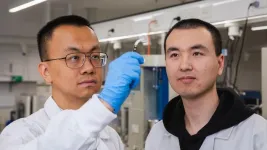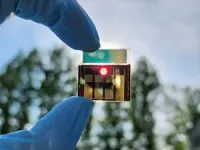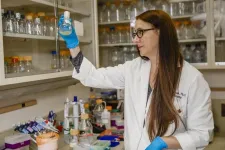(Press-News.org) A global team of researchers and industry collaborators led by RMIT University has invented recyclable ‘water batteries’ that won’t catch fire or explode.
Lithium-ion energy storage dominates the market due to its technological maturity, but its suitability for large-scale grid energy storage is limited by safety concerns with the volatile materials inside.
Lead researcher Distinguished Professor Tianyi Ma said their batteries were at the cutting edge of an emerging field of aqueous energy storage devices, with breakthroughs that significantly improve the technology’s performance and lifespan.
“What we design and manufacture are called aqueous metal-ion batteries – or we can call them water batteries,” said Ma, from RMIT’s School of Science.
The team use water to replace organic electrolytes – which enable the flow of electric current between the positive and negative terminals – meaning their batteries can’t start a fire or blow up – unlike their lithium-ion counterparts.
“Addressing end-of-life disposal challenges that consumers, industry and governments globally face with current energy storage technology, our batteries can be safely disassembled and the materials can be reused or recycled,” Ma said.
The simplicity of manufacturing processes for their water batteries helped make mass production feasible, he said.
“We use materials such as magnesium and zinc that are abundant in nature, inexpensive and less toxic than alternatives used in other kinds of batteries, which helps to lower manufacturing costs and reduces risks to human health and the environment.”
What’s the energy-storage and life-cycle potential?
The team has made a series of small-scale trial batteries for numerous peer-reviewed studies to tackle various technological challenges, including boosting energy storage capacity and the lifespan.
In their latest work, published in Advanced Materials, they’ve triumphed over a major challenge – the growth of disruptive dendrites, which are spiky metallic formations that can lead to short circuits and other serious faults.
The team coated affected battery parts with a metal called bismuth and its oxide (otherwise known as rust) as a protective layer that prevented dendrite formation.
The result?
“Our batteries now last significantly longer – comparable to the commercial lithium-ion batteries in the market – making them ideal for high-speed and intensive use in real-world applications.
“With impressive capacity and extended lifespan, we've not only advanced battery technology but also successfully integrated our design with solar panels, showcasing efficient and stable renewable energy storage.”
The team’s water battery is closing the gap with lithium-ion technology in terms of energy density, with the aim of using as little space per unit of power as possible.
“We recently made a magnesium-ion water battery that has an energy density of 75 watt-hours per kilogram (Wh kg-1) – up to 30% that of the latest Tesla car batteries.”
This research is published in Small Structures.
“The next step is to increase the energy density of our water batteries by developing new nano materials as the electrode materials.”
Ma said magnesium was likely to be the material of choice for future water batteries.
“Magnesium-ion water batteries have the potential to replace lead-acid battery in the short term – like one to three years – and to replace potentially lithium-ion battery in the long term, 5 to 10 years from now.”
“Magnesium is lighter than the alternative metals, including zinc and nickel, has a greater potential energy density and will enable batteries with faster charging times and better capability to support power-hungry devices and applications.”
Potential applications
Ma said the team’s batteries were well suited for large-scale applications, making them ideal for grid storage and renewable energy integration – especially in terms of safety considerations.
“As our technology advances, other kinds of smaller-scale energy storage applications such as powering people’s homes and entertainment devices could become a reality.”
Technology supported by peer-reviewed research, government funding and industry engagement
As part of an ARC Linkage project, Ma’s team is continually developing their water batteries in collaboration with industry partner, GrapheneX, a tech innovator based in Sydney.
“We also collaborate closely with researchers and experts from renowned universities and research institutions in Australia, US, UK, Japan, Singapore, China and elsewhere. These collaborations facilitate knowledge exchange and access to cutting-edge facilities. By drawing on this global team’s expertise in different areas, we can tackle the complex challenges involved from various angles.”
The team’s latest research ‘Synergy of dendrites-impeded atomic clusters dissociation and side-reactions suppressed inert interface protection for ultrastable Zn anode’ is published in Advanced Materials (DOI: 10.1002/adma.202400237).
Details of some recent peer-reviewed publications that underpin the team’s water battery innovations are provided below.
‘Interface polarization effects enhancing Mn2O3@TiO2@MXene heterostructures for aqueous magnesium ion capacitors: guided charge distribution and transportation via built-in electric fields’ is published in Small Structures (DOI: 10.1002/sstr.202300371).
‘Bulk defect-induced phase transition assisting high-flux magnesium ions intercalation in manganese tetroxide’ is published in Energy Storage Materials (DOI: 10.1016/j.ensm.2023.103010).
‘Ammonium-ion energy storage devices for real-life deployment: storage mechanism, electrode design and system integration’, published in Energy and Environmental Science (DOI: 10.1039/D3EE02030D), provides a comprehensive review from Ma’s team of the history, challenges and potential of water batteries.
MULTIMEDIA AVAILABLE FOR MEDIA
Youtube video: New water batteries stay cool under pressure | RMIT University (youtube.com)
Photos and video (without titles, music, etc): https://rmit.mediafire.com/folder/41pyx9ridnla4/Water+battery_Research_Will+Wright
END
New water batteries stay cool under pressure
2024-02-21
ELSE PRESS RELEASES FROM THIS DATE:
Focus on patient experience can improve diabetes care
2024-02-21
WASHINGTON—Health care providers who treat diabetes need to think beyond the clinical numbers, such as solely focusing on a person’s glucose goals. Taking the patient experience into account can improve the quality of care and facilitate attainment of treatment goals, according to a new position statement published in the Endocrine Society’s Journal of Clinical Endocrinology & Metabolism.
The position statement reflects the consensus of two virtual roundtables the Endocrine Society held in 2022. Participants ...
KIER’s success in the development of the world's top-level semi-transparent perovskite solar cells
2024-02-21
The Photovoltaics Research Department of the Korea Institute of Energy Research (hereafter KIER), working with the KIER Energy AI and Computational Science Lab, has achieved advancements in the stability and efficiency of semi-transparent perovskite solar cells. These cells have potential use in building windows and tandem solar cells*. The semi-transparent solar cells achieved a record-breaking efficiency of 21.68%, making them the most efficient amongst the perovskite solar cells using transparent electrodes in the world. Additionally, they showed ...
NIH grant to aid Rumbaugh’s biofilm dispersal research
2024-02-21
Most chronic wound infections share one thing in common: the presence of biofilms, which are composed of many different microorganisms that congregate as a mass, usually on some type of surface such as a wound bed. Biofilms are thought to be associated with up to 80% of infections, and their ability to stick together makes the biofilm and infection exceptionally difficult to kill.
To combat this health care challenge, researchers such as Kendra Rumbaugh, Ph.D., a professor in the Texas Tech University Health Sciences Center (TTUHSC) School of Medicine’s Department of Surgery, are pursuing biofilm dispersal agents such as ...
Study details toxic elements found in stranded whales, dolphins over 15 years
2024-02-21
Whales and dolphins get their nutrients and essential elements through their diet. While eating fish, squid, octopus, crustaceans and other marine mammals, they are also exposed to heavy metal contaminants.
Elevated levels of toxins have been found in stranded dolphins and whales along the Southeastern Coast of the United States. Monitoring toxic contaminants in these stranded marine animals, which serve as important sentinels of environmental contamination, and whose health may be linked to human health, is vital.
Yet, data remain sparse on how specific elements are distributed within an animal’s body, especially for many rarely encountered ...
Inaccurate pulse oximeter readings could limit transplants, heart pumps for Black patients with heart failure
2024-02-21
Racially biased readings of oxygen levels in the blood using pulse oximeters may further limit opportunities for Black patients with heart failure to receive potentially lifesaving treatments, such as heart pumps and transplants, a Michigan Medicine study finds.
“This is especially important because we know that Black patients are already less likely to receive heart pumps or transplants compared to their white counterparts, and these inaccurate readings can further widen a disparity that must be addressed by our health care system,” said first author Scott W. Ketcham, M.D., a third year ...
An awkward family reunion: Sea monsters are our cousins
2024-02-21
KANSAS CITY, MO—February 21, 2024—The sea lamprey, a 500-million-year-old animal with a sharp-toothed suction cup for a mouth, is the thing of nightmares. A new study from the Stowers Institute for Medical Research discovered that the hindbrain—the part of the brain controlling vital functions like blood pressure and heart rate—of both sea lampreys and humans is built using an extraordinarily similar molecular and genetic toolkit.
Research from the lab of Investigator Robb Krumlauf, Ph.D., published on February 20, 2024 in Nature Communications offers a glimpse into how the brains of ancient animals evolved. The team unexpectedly uncovered that ...
Highways through historically redlined areas likely cause air pollution disparities today
2024-02-21
As part of the New Deal, several governmental programs were created to expand homeownership through mortgages and loans. However, neighborhoods with primarily Black or immigrant communities often were rated “hazardous” for repayment under the discriminatory, “redlining” practice that restricted lending. Today, those same areas are exposed to more air pollution than other urban neighborhoods, and according to research published in ACS’ Environmental Science & Technology, the cause could ...
Mercury levels in tuna remain nearly unchanged since 1971, study says
2024-02-21
Tuna is one of the most popular seafoods worldwide. But this protein-rich fish can build up high levels of methylmercury from feeding on contaminated prey, like smaller fish or crustaceans. Despite efforts to reduce mercury emissions into the environment, researchers report in ACS’ Environmental Science & Technology Letters that levels in tuna appear to be unchanged since 1971. They warn that more aggressive emission reduction targets are needed to start nudging down tuna mercury levels.
Environmental ...
Compounds in female ginseng could lead to new osteoporosis treatments
2024-02-21
With ever-increasing life expectancy comes the challenge of treating age-related disorders such as osteoporosis. Although there are effective drugs for treating this metabolic bone disease, they can be expensive and have side effects, limiting their availability to some people. In the search for alternative drug candidates, researchers reporting in ACS Central Science have discovered and fully replicated a compound from a botanical source, female ginseng, that had potent anti-osteoporotic activity in cellular tests.
Osteoporosis and low bone mass impact 54 million American ...
Communities of color breathe Denver’s worst air
2024-02-21
History determines who gets to breathe fresh air, according to a new study published today in Environmental Science and Technology. The CIRES led-study found that historic, discriminatory lending practices known as redlining in the city are linked to inequities in air quality today.
Alex Bradley, a fourth-year chemistry Ph.D. student in CIRES’ de Gouw group at the University of Colorado Boulder, used his background in chemistry coupled with an environmental justice lens to understand how pollution impacts communities of color in Denver.
What he discovered wasn’t ...






